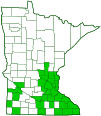pandorus sphinx
(Eumorpha pandorus)
Conservation • Description • Habitat • Ecology • Distribution • Taxonomy
|
|
||||||||||||||||||
Description |
Pandorus sphinx is a very large, dramatically patterned, sphinx moth. It has a wingspan of 3¼″ to 4½″. Females are slightly larger than males. The adult is heavy-bodied and has relatively small wings. The thorax is pale green. The structures on the thorax covering each wing base (tegulae) are dark. The abdomen is long and tapered. The antennae are thread-like, thickened, and somewhat spindle-shaped at the tip. The bristle or group of bristles (frenulum) present on most moths that keep the wings together in flight is present but small on this moth. The forewing is long and narrow, and pointed, with a smooth, slightly convex outer margin. It is pale green with a complex pattern of dark olive-green markings. There is a squarish, dark olive green patch along the inner margin near the base, abutting an even darker patch of similar size and shape in the middle of the inner margin, and a smaller patch on the inner margin near the outer edge. There is also a patch in the median area above the discal cell, and a patch with a pale outline at the tip. Pink streaks over two of the veins extend from the discal area to the subterminal area, and there is a pink streak on the inner margin between the middle and outer dark spots. A pale eyespot in the discal area (discal spot) has two black spots. The hindwing is whitish near the base, grading to pale green near the outer margin. There is a dark olive-green patch in the median area near the inner margin, a dark patch in the subterminal area, and a pink patch at the anal angle. The second (Sc+R1) and third (Rs) veins behind the leading edge of the hindwing are parallel from the base to the end of the discal cell. They are united by an oblique cross-vein at about the middle of the discal cell. The underside of both wings is usually yellowish-green, sometimes pale brown. The caterpillar is up to 3½″ long. It may be green, orange, pink, or reddish-brown. The third thoracic segment (T3) is greatly swollen. When the caterpillar is alarmed, the head, T1, and T2 are withdrawn into it. Caterpillars pass through five stages (instars) before pupating. The third through fifth instar caterpillars have conspicuous pale spots surrounding the breathing pores (spiracles) of the third through seventh abdominal segments (A3–A7). The spots are pale yellow to white and have a thin black border. A2 sometimes has a similar but much smaller spot. The thorax and A1–A3 are generously peppered with tiny black dots. These gradually dissipate further down the abdomen. There is a slender, coiled, whip-like horn at the back (posterior) of A8 on all early instar caterpillars. This is replaced by a hardened, slightly raised eyespot on the last instar. Mature caterpillars can be found from July to November. They are very large and consume copious amounts of foliage. They can completely defoliate young grape vines, ultimately killing them. Older vines can withstand the damage. |
Size |
Total length: 1¾″ to 2⅜″ Wingspan: 3¼″ to 4½″ |
Similar Species |
Achemon sphinx (Eumorpha achemon) is smaller and less common. Adults are brown, not green. The caterpillars have much more peppering on all abdominal segments. The pale spots over the spiracles are notched, dividing them into three parts, and giving them a coiled appearance. |
Habitat |
Forest edges, woodlands, fields, river margins, vineyards, gardens |
Ecology |
Season |
One generation per year: May to September (Wisconsin) |
Behavior |
Adults fly at dusk. |
Life Cycle |
Adults emerge in June. Females attract males by releasing pheromones at night. After mating, the female lays translucent green, almost spherical eggs singly on the underside of host plant leaves. The eggs hatch in 6 to 8 days. The caterpillars feed on the leaves. They pass through five instars. In the fall, fifth instar caterpillars burrow 4″ to 6″ into the soil, pupate, and overwinter. The pupae wiggle to the soil surface just before emergence (eclosion). |
Larva Hosts |
In Minnesota, leaves of grape (Vitis spp.) and Virginia creeper (Parthenocissus spp.). Elsewhere, also peppervine (Ampelopsis spp.). |
Adult Food |
Nectar of a variety of flowers |
Distribution |
||
|
Sources |
|
| 8/25/2024 | ||
Occurrence |
||
Common and widespread in eastern United States |
||
Taxonomy |
|
Order |
|
Superfamily |
Bombycoidea (Hawk, Sphinx, Silk, Emperor, and Allied Moths) |
Family |
|
Subfamily |
Macroglossinae (small sphinx moths) |
Tribe |
Philampelini |
Genus |
Eumorpha |
The name of the subfamily, Macroglossinae, is shared with a subfamily of large bats (megabats). This violates the rules of the International Code of Zoological Nomenclature (ICBN), and one of the subfamilies will probably be renamed in the future. |
|
Subordinate Taxa |
|
|
|
Synonyms |
|
Eumorpha pandora |
|
Common Names |
|
pandora sphinx pandorus sphinx pandorus sphinx moth |
|
Glossary
Frenulum
A spine (male) or multiple spines (female) at the base of the costal edge of the hindwing of many moths that couples with the retinaculum on the forewing to keep the wings in contact which each other.
Instar
The developmental stage of arthropods between each molt; in insects, the developmental stage of the larvae or nymph.
Pupa
The life stage of some insects undergoing transformation. In caterpillars, the chrysalis. Plural: pupae.
Spiracle
A small opening on the surface of an insect or arachnid through which it breathes.
Tegula
A small, hardened, plate, scale, or flap-like structure that overlaps the base of the forewing of insects in the orders Lepidoptera, Hymenoptera, Diptera, and Homoptera. Plural: tegulae.
Visitor Photos |
||
Share your photo of this insect. |
||
This button not working for you? |
||
Ruth Johnson |
||
 |
|
|
| found one of these caterpillars in a roadside ditch near my home in Rochester (Olmsted County). A first for me! I thought I would share it with you. 🙂 |
|
|
Mike B. |
||
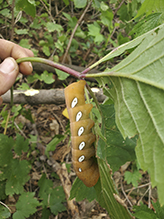 |
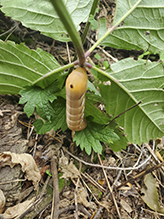 |
|
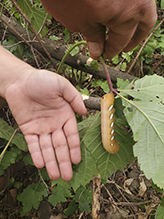 |
||
Chad & Autumn Brekke |
||
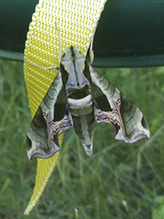 |
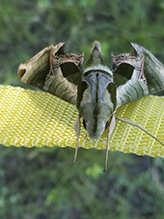 |
|
Found resting on our kids swing set |
||
MinnesotaSeasons.com Photos |
||
|
||
|

Slideshows |
|

Visitor Videos |
||
Share your video of this insect. |
||
This button not working for you? |
||
|
Other Videos |
||
Pandorus Sphinx Moth - CTnaturalist Online |
About
Published on Jul 10, 2010 The Pandorus Sphinx Moth is a large nocturnal moth with a wingspan reaching lengths of 4 1/2 inches. This specimen is resting during the daylight hours, until dusk arrives. The remarkable color patterns make this species a wonderful find for any nature enthusiast. Large compound eyes help the moth navigate in darkness. It's body is covered with small hairs, a macro lens offers an up-close look. Females lay single eggs on the leaves of grape vines and Virginia Creeper, the favorite foods of their caterpillars. Today, our moth is perched on a wild grape leaf. Caterpillars feed voraciously and overwinter as a pupa underground. Adults are active on summer nights and often feed on the nectar of suburban garden flowers -- including petunias. Be on the look out in your backyard this summer. If you're lucky, you too will spot the beautiful, pandorus sphinx moth. |
Cool Bug: "Pandorus Sphinx Moth".. visiting my veggie garden |
About
Published on Jul 25, 2010 What IS this cool bug? ANSWER: "Pandorus Sphinx Moth" (Eumorpha pandorus). (For a while we thought it was "Oleandar Hawk Moth", an African-Asian moth never before seen in North America, but alas it is a more common moth, but still just as beautiful). Filmed July 14, 2010, on the leaf of a cucumber or gourd in my front yard vegetable garden, northeaster USA. |
Pandorus Sphinx Moth caterpillar (Eumorpha pandorus) |
About
Published on Sep 8, 2014 Pandorus Sphinx Moth caterpillar, Eumorpha pandorus |
Pandora Sphinx Moth (Eumorpha pandorus) |
About
Published on Jul 24, 2014 Video of a Pandora Sphinx Moth also known as Eumorpha pandorus, found in Frederick, Maryland in late July 2014. For more information go to: https://en.wikipedia.org/wiki/Eumorpha_pandorus |
Pandora Sphinx moth showing off her wings. |
About
Published on May 7, 2010 She was hanging out on my front porch, so I brought her in for a visit. She is vibrating her wings, probably to scare me. I think she's beautiful. And of course, I let her go back outside after I took a few pictures and recorded this. |

Visitor Sightings |
||
Report a sighting of this insect. |
||
This button not working for you? |
||
Ruth Johnson |
Location: Rochester, MN I found one of these caterpillars in a roadside ditch near my home in Rochester (Olmsted County). A first for me! I thought I would share it with you. 🙂 |
 |
| Mike B. 8/26/2023 |
Location: Sherburne County |
| Chad & Autumn Brekke 7/20/2018 |
Location: Kilkenny, Minnesota Found resting on our kids swing set |
 |
MinnesotaSeasons.com Sightings |
||
|

Created 7/22/2018 Last Updated: © MinnesotaSeasons.com. All rights reserved. |
